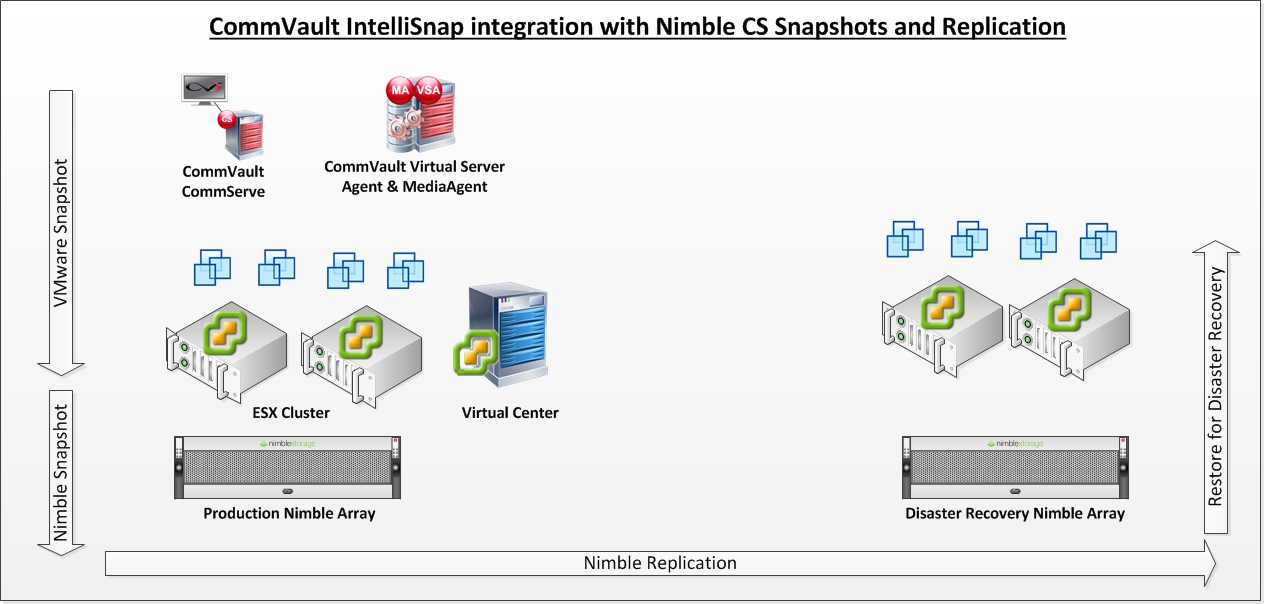- Community Home
- >
- Storage
- >
- HPE Nimble Storage
- >
- Application Integration
- >
- Integrating Nimble Storage and CommVault Simpana f...
Categories
Company
Local Language
Forums
Discussions
Forums
- Data Protection and Retention
- Entry Storage Systems
- Legacy
- Midrange and Enterprise Storage
- Storage Networking
- HPE Nimble Storage
Discussions
Discussions
Discussions
Forums
Discussions
Discussion Boards
Discussion Boards
Discussion Boards
Discussion Boards
- BladeSystem Infrastructure and Application Solutions
- Appliance Servers
- Alpha Servers
- BackOffice Products
- Internet Products
- HPE 9000 and HPE e3000 Servers
- Networking
- Netservers
- Secure OS Software for Linux
- Server Management (Insight Manager 7)
- Windows Server 2003
- Operating System - Tru64 Unix
- ProLiant Deployment and Provisioning
- Linux-Based Community / Regional
- Microsoft System Center Integration
Discussion Boards
Discussion Boards
Discussion Boards
Discussion Boards
Discussion Boards
Discussion Boards
Discussion Boards
Discussion Boards
Discussion Boards
Discussion Boards
Discussion Boards
Discussion Boards
Discussion Boards
Discussion Boards
Discussion Boards
Discussion Boards
Discussion Boards
Discussion Boards
Discussion Boards
Community
Resources
Forums
Blogs
- Subscribe to RSS Feed
- Mark Topic as New
- Mark Topic as Read
- Float this Topic for Current User
- Bookmark
- Subscribe
- Printer Friendly Page
- Mark as New
- Bookmark
- Subscribe
- Mute
- Subscribe to RSS Feed
- Permalink
- Report Inappropriate Content
03-22-2015 06:40 PM
03-22-2015 06:40 PM
Integrating Nimble Storage and CommVault Simpana for Better Data Protection
Hardware, storage array based snapshots offer us a great technology to solve some of the more difficult challenges associated with data protection – they allow us to:
|
CommVault provides hardware array snapshot management under the IntelliSnap component of the Simpana 10 product. CommVault IntelliSnap extends Nimble Storage snapshots by providing application awareness for many enterprise applications, with granular indexing and single item recovery, without scripting, and from a central management console. Nimble Storage was the first storage array to be certified through CommVault's IntelliSnap Connect Program (ICP) which integrates native Nimble Storage snapshot functionality with CommVault Simpana software. Whilst integration was first introduced in CommVault Simpana 9.0 R2 SP6, this tutorial will focus on the integration with Simpana 10 SP7A and Nimble Storage OS version 2.1 and higher.
There are a few key factors which can define success and failure in a hardware integrated data protection environment:
- A good hardware snapshot implementation is mandatory and without it the results can be woeful
- All-inclusive licensing for hardware snapshots and replication is highly advantageous from a cost and manageability perspective
- Reduced complexity – the ability to deploy IntelliSnap with few or no extra hardware or software components reduces the complexity of troubleshooting and maintenance
Nimble Storage is all about making the purchasing, installation and management of data storage easy, and its integration with CommVault IntelliSnap is no exception. Integrating IntelliSnap with Nimble Storage requires no additional Nimble licenses and no additional or specific versions of storage software to install, upgrade or configure. With Nimble, you just enter the Group Management IP address, username and password in the CommVault Array Management dialog and you are ready to go. Nimble has an exceptional hardware snapshot implementation which provides a great foundation for implementing a snapshot based data protection architecture. Snapshots on Nimble are near-instantaneous, have zero performance impact, and consume very little space on the NL-SAS drives. So you can take snapshots galore and retain them for a long period of time to meet all of your disaster recovery and backup requirements.
Some useful cases where a hardware snapshot methodology may make sense in your CommVault architecture are:
- Performing Virtual Server backups of VMware – IntelliSnap integration dramatically shrinks your backup window and enhances the reliability and scalability of your Virtual Server backups
- Large Databases – Protecting large databases with a short RPO and RTO can be challenging and resource intensive under a streaming backup methodology. CommVault IntelliSnap with Nimble Storage snapshots, offer the ability to instantaneously and frequently protect these databases without impact on the production instance
- Large file systems with a short Recovery Time Objective – protecting large file systems and providing a short Recovery Time Objective for them can be difficult. CommVault IntelliSnap and Nimble Storage snapshots and replication provide a mechanism to streamline data protection and offer a mechanism to very quickly restore the data in the event of a disaster
In the next three blog posts we will explore how to integrate CommVault Simpana IntelliSnap and Nimble Storage to provide a modern data approach for these three use cases.
 | But before we jump too far into this, it’s worth pointing out that data protection best practice dictates that we should always ensure that we also have a copy of the data off the array. We can either replicate these snapshots to another array or offload them to tape or remote disk for an offsite copy. In this article we are using replication to another array to provide this offsite copy, and this snapshot and replication combination provide us with a very powerful tool to cost-effectively and efficiently enhance our backup and disaster recovery strategy without tapes and long backup windows. We could also have offloaded this to tape or backup disk using a process that CommVault calls a Backup Copy – more on this can be found in the CommVault documentation: http://documentation.commvault.com/commvault/v10/article?p=features/snap_backup/nimble/overview.htm |
Virtual Server backups for VMware
The CommVault Simpana Virtual Server Agent protects virtual machines by integrating with the VMware API for Data Protection (VADP) framework. This provides full VM container, VMDK or individual file level recovery for virtual machine data. Integrating IntelliSnap with the CommVault Virtual Server Agent allows customers to instantaneously and frequently drive snapshots of virtual machines scheduled and configured from within the Simpana GUI – termed the CommCell Console. The Virtual Server Agent / IntelliSnap combination allows customers to dramatically shrink their backup windows and increases the scalability of the solution by protecting more virtual machines within the backup window. With standard VADP backups, large virtual machines or virtual machines with a high rate of change can fail during the backup or VMware snapshot consolidation phase. The Virtual Server Agent with IntelliSnap solves this problem by releasing the VMware snapshot directly after the hardware snapshot is completed, typically within seconds.

Before you dive in and configure this up, it’s worth having a read through the Nimble Storage Best Practices Guide: CommVault Simpana, located under the downloads tab in InfoSight. This guide provides comprehensive architectural guidance on how to achieve a reliable IntelliSnap protection strategy. CommVault also has a comprehensive user guide for configuring IntelliSnap on Nimble located at the following link: http://documentation.commvault.com/commvault/v10/article?p=features/snap_backup/nimble/overview.htm
There are also some TCP port requirements to allow CommVault Simpana to talk to the Nimble Storage array.
| CommVault Source | Nimble Destination | TCP Port |
|---|---|---|
| MediaAgent IP | Group Management IP Each Data IP address or the VTIP address | 5391 (Nimble SOAP Port) |
Integrating CommVault IntelliSnap with Nimble Storage involves some very basic steps:
- Configure a Nimble Volume Collection for snapshots and replication of all the volumes we wish to include in the IntelliSnap process
- Configure the Nimble Storage array in the CommVault Control Panel -> Array Management dialog
- Configure a CommVault Storage Policy for the IntelliSnap backups to reside within
- Finally we enable IntelliSnap on the client and subclient for which we want to protect
As with any new technology implementation, you should always start by protecting a small number of virtual machines first. This way you will be able to observe, learn and understand the nuances of IntelliSnap before performing a staged rollout to a wider virtual machine workload.
In the video below, we show the steps required to configure CommVault IntelliSnap with Nimble Storage. Video is best viewed in Full Screen mode at 720p quality.
Now that we have IntelliSnap configured, the video below will show you how to initiate your first IntelliSnap backup and replicate that snapshot to an alternate site. You’ll also see how to restore an individual file from the snapshot and how to perform a disaster recovery from the snapshot in the remote site.
Troubleshooting
If you have configured it all and it’s not working, there are a few things worth checking:
- Arrays – In the Simpana Array Management dialog, have you configured an array for both the Group Management IP and any Data IP or VTIP addresses?
- DNS – Can the CommServe and the MediaAgent resolve the DNS name you have entered in the Simpana Array Management dialog?
- TCP connectivity – Can you successfully telnet to port 5391 on the Nimble Storage array from the MediaAgent server?
- User Account – Can you log into the Nimble web interface with the username/password combination that you have configured inside the Simpana Array Management dialog
If all the above are working, there are a couple of CommVault log files which may help you find the problem:
| CommVault Server | Log File(s) |
|---|---|
| CommVault MediaAgent | {SIMPANA_BASE}\Log Files\vsbkp.log {SIMPANA_BASE}\Log Files\cvma.log {SIMPANA_BASE}\Log Files\vsvmi.log |
Wrapping it up
Snapshots really are the pinnacle of data protection as they provide the ability to achieve short RPOs and RTOs for your business - but not all snapshots are equal. A CommVault IntelliSnap and Nimble Storage based snapshot architecture provides the ability to extend snapshots to a wide range of enterprise applications, monitored and managed through a single interface and configuration methodology and without complex scripting. With Nimble, you can keep as few or as many snapshots as you like, for as long as you like, consuming only a small amount of space and with zero performance impact. Those snapshots can be used to revert/restore a volume locally or remotely when replicated, or you can clone that snapshot to a new volume without consuming any space to cover all your test/development/reporting or DR testing requirements.
IntelliSnap provides a nice addition to a standard CommVault Virtual Server Agent backup architecture. In a single site architecture, IntelliSnap helps you to shrink your backup window, reduce the CPU and network performance impact of backups by offloading this load to a separate proxy host and maintain multiple recovery points on the SAN which you can access at any time.
In the next document we'll look at using IntelliSnap to provide a very efficient data protection strategy for SQL databases.
